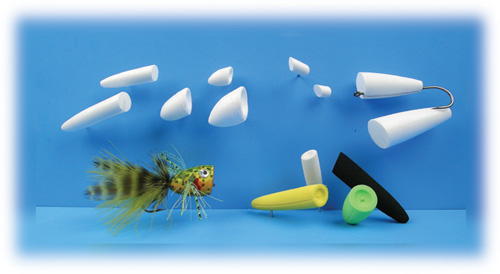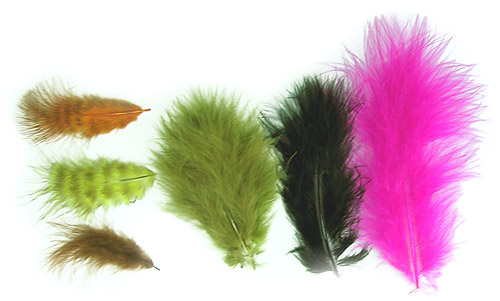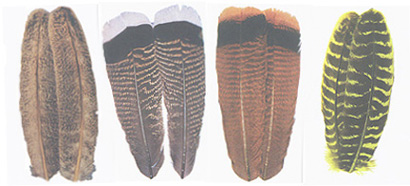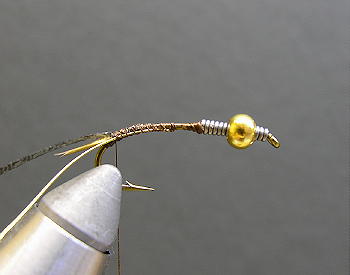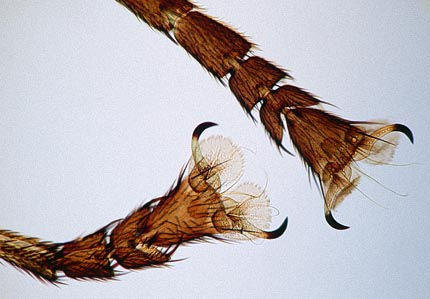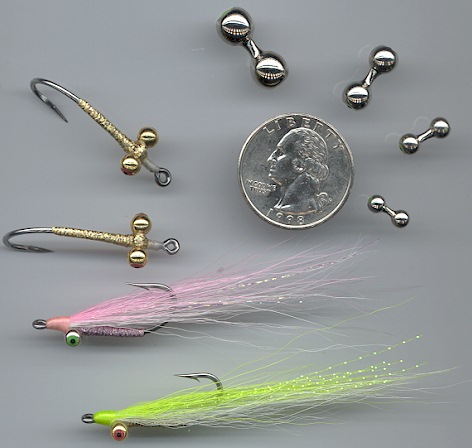|
FLY TYING MATERIALSNatural & Synthetic
Fly Tying Materials , Part 1 Congratulations! Now you're ready to start tying your own flies. But where do you begin? You'll need lots of fly tying materials. What kind of materials do you need? If this is your very first time, you may want to begin with a fly tying kit. The Wapsi Deluxe Starter Kit includes their handbook to help you use, step by step, the most necessary tools, hooks, fur, feathers, adhesive and everything else you need to make 17 different fly patterns, including a clouser minnow, an all purpose nymph and a poly caddis. The starter kit has been tested by fly tying amateurs and the handbook has been written with beginners in mind. This is the easist way to turn those fly tying materials into your own fly creations. Once you become familiar enough to venture out on your own, you can start buying your fly tying materials individually. You'll find a wide variety of feathers, fur and synthetic fibers are the most popular fly tying materials. Here is a rundown of some of the most popular natural choices for tying flies.
Marabou - one of the most popular of fly tying materials Marabou is the soft, fluffy, downy feathers from turkeys and chickens. It is named after the Marabou stork from South Africa, which was once the sole source of this fluffy material. In the late 1930s, it was noticed that turkey down was very similar, and a new industry was born. Marabou is now one of the by-products of poultry processing. The larger white turkey feathers are sold to China for boas, leaving the shorter, downy feathers for marabou. These feathers are dyed many different colors, and come in several different types, including select marabou plumes, strung marabou or blood quills, wooly bugger marabou, mini marabou or chickabou, and grizzly marabou or grizzly chickabou. The last two come from chickens. Hackles Hackles (fly tying materials which add realism to you creation) are the long, thin feathers found on the necks and saddles of chickens. Longer hackles are from roosters, while the shorter varieties are from hens. The longest, thinnest rooster hackles are premium grade. These premium hackles are used for large streamers and wooly buggers. You can buy them singly or in saddle patches. The Keough Hen Saddle Patches are very webby and make a perfect choice for traditional wet flies, as well as salmon and steelhead flies.
Turkeys, Ducks, Wild Birds and Exotics Turkey feathers are used in so many different ways as fly tying materials. Long thin biots are dyed to match insect hatches. They are perfect to use on spinners, nymphs, emergers and dry flies. Flats are best used for wings and parachute posts. Quills are excellent for muddlers, hopper wings, stonefly nymphs and mayfly nymph wing cases. Tail feathers can be dyed according to your need, and can be used for tails, legs, and specific insect species. Duck down adds a fluffiness you can't get from anything else. Duck feathers are perfect for many salmon flies, with their natural barring patterns. Partridge, pheasant and guinea feathers are perfect for nymphs, large spey flies and soft hackle flies. The natural patterning of the feathers add a lot to the look of your flies. You can get wild bird feathers as single feathers or in patches or skins. Peacock feathers are great for salmon flies because the fish really respond to the iridescence. Ostrich feathers are good for gilled nymphs, tentacles and other details. So there you have fly tying materials in a nutshell (so to speak). Now, it's your turn. Go forth and create!!! 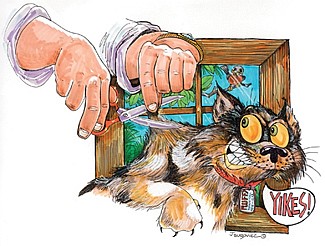
Animal Fur Animal fur has been used as fly tying material for generations. You can get it in natural or brightly dyed colors, so you can make almost any fly you can imagine. Bucktails are a good source of fur that is a solid color. This is the white part of the tail of a whitetail deer. Deer fur is also available in many different varieties, depending on what you want. Belly hair is usually dyed and is used for medium to large hair bugs. Body hair is agouti colored and may be dyed. Hair strips gives you a large amount of hair to work with. Short, fine deer hair is perfect for muddlers, hoppers and crickets. You need to be aware that different species will have different hair characteristics. Whitetail is different than mule deer, for example. Elk hair is similar to deer, but a little longer and thicker. Rump hair is perfect for hoppers. Rabbit fur is available in more colors than any other fiber. You can buy rabbit in full skins, strips or masks. Rabbit fur works better than anything for sculpins, tarpon bunnies and bonefish flies. Squirrel is perfect for small streamers or nymphs. Squirrel zonkers are cut in 1/8" wide strips for easy wrapping. Fly Tying Materials, Part 2 Today there are a lot of synthetic fly tying materials as well as blends of synthetic with natural fibers. Although there is natural fur dubbing, most dubbing is a blend of natural fiber with a fluffy synthetic that contains a unique sparkle that the fish love. This fiber can be used for nymphs, caddis flies and other patterns where you need a little translucence. You can get 100% sparkle dubbing, or you can find it blended with squirrel and other natural fibers. Foam poppers make it easy to tie large flies. These variously shaped pieces of foam float high in the water and are very durable. You can cut, trim or sand them to create the shape that you want. Poppers come in several colors, sizes and shapes. You can decorate them how you like to create some fabulous flies. If you'd like to hone your skills working with foam, try out the Wapsi Foam Fly Material Kits. The kits come with complete instructions and all the materials to make 24 flies. You'll learn how to make ants, beetles, spiders and more. Once you've learned the ins and outs of foam flies, you can buy your own foam bug bodies. They are soft and flexible, but the make very durable flies. Foam ant bodies can be used for grasshoppers, crickets and stoneflies. The beetle body can also be used as a spider or can be attached to a streamer to help it float better. The spider body floats extra high in the water, and is a favorite for bass and panfish. The spider body also makes an excellent cicada. Another fine foam product for fly tying is Wild Wild Foam. These sheets of foam have holographic and other reflective patterns that cannot be duplicated any other way. The fish really like flies made with this unusual material.
Thin Skin is an extremely thin material that is transparent and stretchable. One side has a matte finish, while the other is shiny. It is easy to cut into strips of any size. This material is available in many solid colors as well as mottled and fly speck patterns. It makes the ideal material for wing cases and shellbacks on sowbugs or scuds. It can also be used to create crayfish or shrimp patterns.
Sili Legs are legs impregnated with silicone. This gives them a translucency and flexibility that you can't get with standard rubber legs. They are available in barred, nymph, chrome, speckle flake, metallic and fire tip styles. T. N. T. Hopper Legs are molded from real hopper legs in a soft, flexible material that react very naturally in the water. The legs are available in 9 different colors to match the grasshoppers and crickets in your region. Synthetic wing materials are easy to use. You can use Sheer Wing for midges, caddis flies, mayflies and stoneflies. It works just right with either stencils or burners and is easy to cut to the right shape. Sparkle Organza is the perfect material for spinner wings, shellbacks, scuds and shucks. Pull the fibers from the side of the sheet until you have enough for the job you need to do. Tyvek Wing Sheet is easy to cut to shape for wing pads on shellbacks and mayflies. Stencils are available for mayfly, stonefly and caddis wings. Just lay the stencil on the wing material, trace it and then cut out the shape. Tie the piece of cut material to your fly according to the pattern you are following. Ultra Wing is another wing material you may find yourself wanting to try. It comes in a variety of colors and not only makes excellent wings, it makes a good baitfish pattern as well, such as minnows or herring. Wooly Bugger Chenille is a nylon filament yarn that makes it easy to tie a wooly bugger. It offers the right amount of flash and sparkle as well as resistance to matting. Palmer Chenille is made of mylar and adds the right amount of flash to your flies.
Beads are used for eyes and heads on some flies. Coneheads, dumbbell eyes, tungsten beads and eyes are all easy ways to make your flies noticeable to the fish. You obviously need tying material to put it all together. Ultra wire, ultra tinsel, ultra thread and GSP thread all fill the bill admirably. They come in a variety of colors to match any fly you want to create.
|





